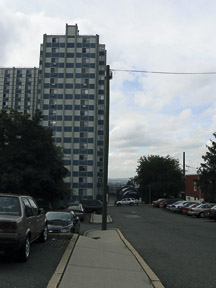Bedbugs bite – and they’re awfully hard to get rid of once they invade your mattress.
Unfortunately, they’ve recently been spotted in a North Bergen senior housing building, and officials are trying to deal with the problem.
The creepy insect feeds off of blood from humans and other mammals. They’re hard to detect, reproduces up to 500 times in its lifetime, and can go without food for up to 18 months.
More than 50 years ago, the widespread use of DDT caused many to believe that bedbugs had been eradicated in the United States. Once that pesticide was banned, it is believed that bedbugs, or cimicidae, began to thrive, especially in multi-occupancy buildings like hotels and apartments.
“We have been getting complaints over the last three years.” – Richard Censullo
________
Last week, the North Bergen Reporter received an email from a resident who said that a friend living at the Cullum, a 308-unit North Bergen senior housing building, along with “many other families,” had now “been plagued with bedbugs all over their home, furniture and clothing.”
They claimed the bugs had been seen on “every floor” and that residents have been forced to throw their furniture away and pay $200 for an exterminator.
Last week, North Bergen Housing Authority Executive Director Diana Peirano-Ingvaldsen confirmed that bedbugs had been sighted in the building. She said there had been only three or four incidents in the Cullum building in total.
“We have been getting complaints over the last three years [throughout North Bergen],” said Health Officer Richard Censullo last week.
Censullo, who is also the health officer for Union City and Bayonne, noted that the insects can be found in the “finest” of hotels, hospitals, and homes. He said that infestations were not a matter of cleanliness, but often occur when people take in used mattresses or furniture that unbeknownst to them, houses bedbugs.
Their eggs are “almost impossible to destroy,” said Censullo.
Difficult to kill
Censullo said that a large problem is used mattresses and second-hand furniture that can transfer bedbugs.
He said that since DDT, it doesn’t seem that any other chemical has the “kill power” to control the population.
Exterminations are often successful after the second visit or more follow-ups in case eggs have hatched.
According do Rutgers University Assistant Extension Specialist Dr. Changlu Wang, an expert in entomology who has studied urban pest control, residents may not have any noticeable signs of infestation or bites. If residents are notified of signs to watch for, hopefully they’ll report cases before letting them go undetected.
In severe cases, furniture and other personal belongings will likely have to be disposed of and common areas in buildings may also need to be treated, said Wang.
It is possible for a building to only have a few documented cases, but within a few years, have a situation where 50 percent of a 250-unit building is infested.
Wang said that these bugs are often not detected until they’ve spread to the next apartment through doors or even electrical outlets. Much of his research has centered on the need for more proactive monitoring to test for low infestation levels.
Wang monitored a high-rise building in Indianapolis, Ind. from its first bedbug problem. More than two years later, 45 percent of the apartments had been infected.
Community problem
Wang said often management offices in housing authorities aren’t always quick to attend the problem, or do not want to spend for follow-up treatments due to the expense. He said that buildings should be monitored once a month “very diligently.”
Censullo said that the local housing authorities do a good job of reacting.
“In all of the cities that I represent, they have exterminators that are there, and because of the number of units they oversee in Union City and North Bergen and even Bayonne, those housing authorities get right on it because they know very well what could happen if the situation gets out of control,” said Censullo.
Peirano-Ingvaldsen said that the issue of bedbugs is checked out on a biweekly basis and that when they find a tenant has taken in used furniture, extermination follow-ups follow.
According to New Jersey law, a landlord must deal with a bedbug infestation immediately, but can pass the bill to the tenant.
While tenants must pay, Peirano-Ingvaldsen said that there are only isolated cases.
Wang said that residents must also be aware and collaborate in order to stop infestations from rapidly growing.
“Some residents are very cautious and they are very careful of the bedbugs and some aren’t,” said Wang. “Those who don’t care about residents become reservoirs.”
Two Cullum residents agreed to comment on the issue, but declined to give their names. One said that while he did not have a bedbug problem, it was widely known that many residents did have infestation issues.
Another resident said he never heard of such problems and praised the management office for their quick resolution to similar problems in the past.
Density of New Jersey
Wang said that New Jersey and its housing authorities have a unique density problem. Censullo agreed, stating that Union City is the most densely populated city in the United States.
Wang said that when he first moved to New Jersey, he noticed the diversity and mobility of people. This constant international and local travel compounds the problem.
“The housing conditions are also much more crowded than other states,” said Wang. “Because of the population density, the crowding housing condition and the diversity of people, there will always be some issue of the spread of begbug populations within, between, and in communities.”
